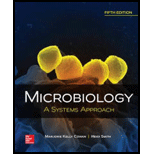
Concept explainers
A virus is a tiny infectious
- a. cell.
- b. living thing.
- c. particle.
- d.
nucleic acid .
Introduction:
Viruses are the small infectious particle that causes severe or mild infections in humans, plants, and animals. Viruses are not alive when they are present outside the host body. They need a host to reproduce or replicate. A virus contains a capsid (coat protein), nucleic acid, and an envelope (lipid membrane)
Answer to Problem 1MCQ
Correct answer:
A virus is a tiny microscopic infectious particle. Therefore, option (c) is correct.
Option (c) is given as “particle”.
Explanation of Solution
Justify reason for the correct statement:
Viruses are the lifeless molecule and unable to multiply independently from the host cell. They are not living, but when they are present in a host they possess certain processes of the living organismbut do not exhibit most of the processes. Therefore, viruses can be better described as the infectious particles rather than organisms.
Hence, option (c) is correct.
Justify reasons for the incorrect statements:
Option (a) is given as “cell”.
Viruses are not made of cells. Hence, it is a wrong answer.
Option (b) is given as “living thing”.
Viruses are not living things because they are unable to multiply or grow in number independently from the host cell. Hence, it is a wrong answer.
Option (d) is given as “nucleic acid”.
Viruses do contain a nucleic acid, but they cannot be defined as an infectious nucleic acid because it is one of a component of a virus. Hence, it is a wrong answer.
Hence, options (a),(b), and(d) are incorrect.
Hence, viruses can be defined as the tiny infectious particles.
Want to see more full solutions like this?
Chapter 6 Solutions
Microbiology: A Systems Approach
- A complete functional virus that has the capacity to infect the living tissue. A. NOTA B. Virophage C. Viroid D. Bacteriophage E. VIRIONarrow_forwardDefine the following terms: a. virus b. virion c. capsid d. retrovirus e. enveloped virusarrow_forwardWhich of the following statements about viruses is false? a. Viruses require a host cell to reproduce. b. Viruses are sensitive to interferons. c. Viral infections can generally be controlled with antibiotics. d. Viruses encode their own genome.arrow_forward
- Viruses contain either DNA or RNA. Viruses possess their own metabolic system a. FIRST statement is TRUE; SECOND statement is FALSE b. BOTH Statements are TRUE c. FIRST statement is FALSE; SECOND statement is TRUE d. BOTH statements are FALSEarrow_forwardA researcher, studying two different animal viruses (A and B) that infect the same cell type, digests away all the protein and transfers the nucleic acid directly into the host cell. Only virus B causes the infection. This suggests: a. Virus A is likely to be a naked virus. b. Virus A is likely to be an enveloped virus. c. Virus A is likely to be a -ssRNA virus. d. Virus A is likely to be a +ssRNA virus. e. Virus A is likely to be a dsDNA virus. And now explain why.arrow_forwardChoose the correct word: The virus attacks ______________ cells in the brain. Select one: a. specific b. wealthy c. beneficial d. intensivearrow_forward
- A virus needs a ______ cell in order to reproduce. A. Large B. Host C. Weak D. Deadarrow_forwardWhat's the term to describe a mutant viral protein, apart from any genetic material, that can cause disease?O A. VirusO B. VirionO C. ViroidO D. Prionarrow_forwardThe --------------- retrovirus contains a ______________ genome: Select one: a. chicken pox, circular DNA b. Sars CoVII, double-stranded RNA c. measles, double-stranded DNA d. HIV, Single-stranded RNAarrow_forward
- Which receptors of the influenza virus are responsible for binding tothe host cell?a. hemagglutinin b. neuraminidase c. type A d. capsid proteinsarrow_forwardThe envelope of an animal virus is derived from the of its host cell. Select one: A. Cell wall B. Receptors C. Glycocalyx D. Membranearrow_forwardSelect a drug or drugs that can prevent a viral nucleic acid from beingreplicated.a. retrovir b. acyclovir c. saquinavir d. both a and barrow_forward
 Human Anatomy & Physiology (11th Edition)BiologyISBN:9780134580999Author:Elaine N. Marieb, Katja N. HoehnPublisher:PEARSON
Human Anatomy & Physiology (11th Edition)BiologyISBN:9780134580999Author:Elaine N. Marieb, Katja N. HoehnPublisher:PEARSON Biology 2eBiologyISBN:9781947172517Author:Matthew Douglas, Jung Choi, Mary Ann ClarkPublisher:OpenStax
Biology 2eBiologyISBN:9781947172517Author:Matthew Douglas, Jung Choi, Mary Ann ClarkPublisher:OpenStax Anatomy & PhysiologyBiologyISBN:9781259398629Author:McKinley, Michael P., O'loughlin, Valerie Dean, Bidle, Theresa StouterPublisher:Mcgraw Hill Education,
Anatomy & PhysiologyBiologyISBN:9781259398629Author:McKinley, Michael P., O'loughlin, Valerie Dean, Bidle, Theresa StouterPublisher:Mcgraw Hill Education, Molecular Biology of the Cell (Sixth Edition)BiologyISBN:9780815344322Author:Bruce Alberts, Alexander D. Johnson, Julian Lewis, David Morgan, Martin Raff, Keith Roberts, Peter WalterPublisher:W. W. Norton & Company
Molecular Biology of the Cell (Sixth Edition)BiologyISBN:9780815344322Author:Bruce Alberts, Alexander D. Johnson, Julian Lewis, David Morgan, Martin Raff, Keith Roberts, Peter WalterPublisher:W. W. Norton & Company Laboratory Manual For Human Anatomy & PhysiologyBiologyISBN:9781260159363Author:Martin, Terry R., Prentice-craver, CynthiaPublisher:McGraw-Hill Publishing Co.
Laboratory Manual For Human Anatomy & PhysiologyBiologyISBN:9781260159363Author:Martin, Terry R., Prentice-craver, CynthiaPublisher:McGraw-Hill Publishing Co. Inquiry Into Life (16th Edition)BiologyISBN:9781260231700Author:Sylvia S. Mader, Michael WindelspechtPublisher:McGraw Hill Education
Inquiry Into Life (16th Edition)BiologyISBN:9781260231700Author:Sylvia S. Mader, Michael WindelspechtPublisher:McGraw Hill Education





